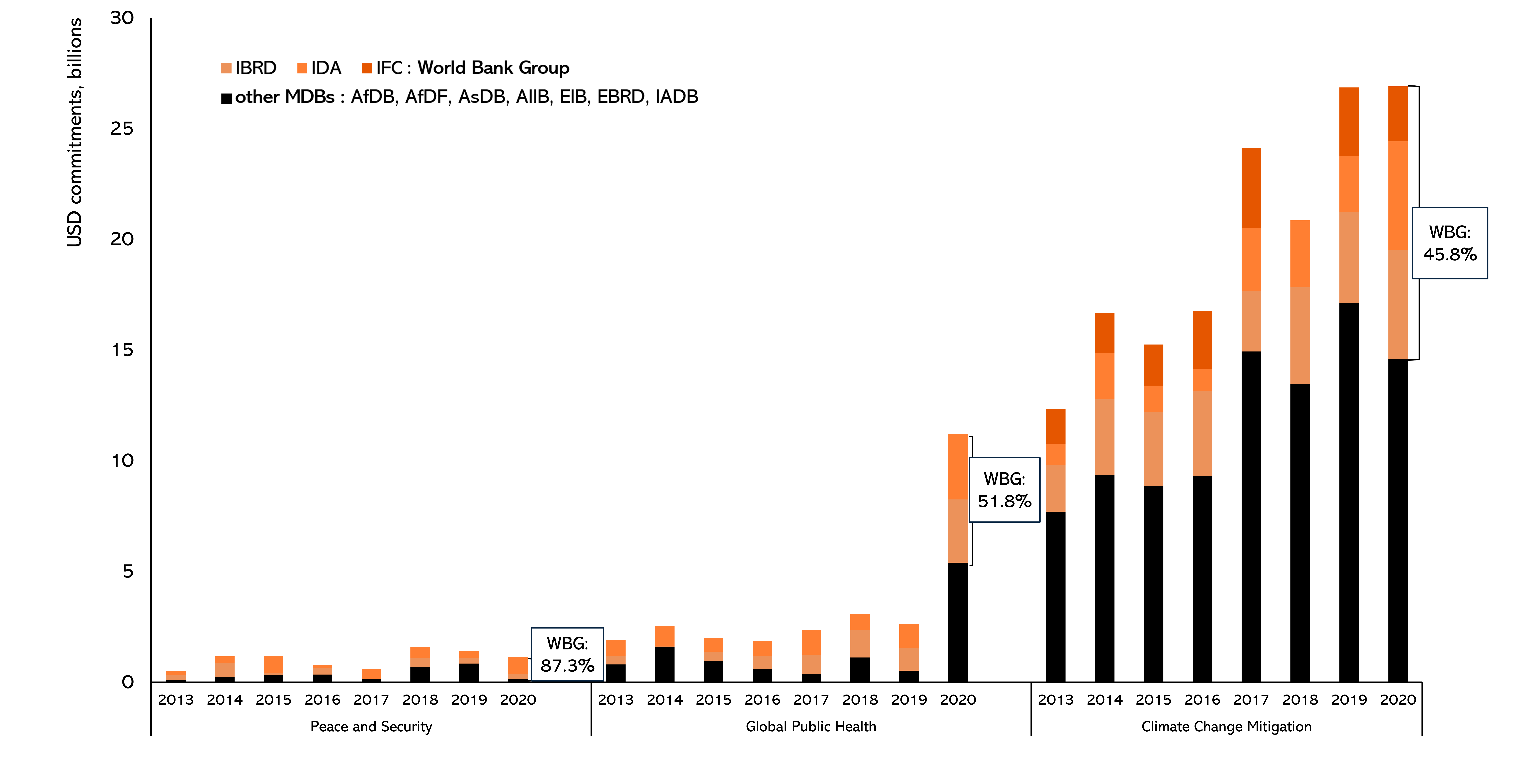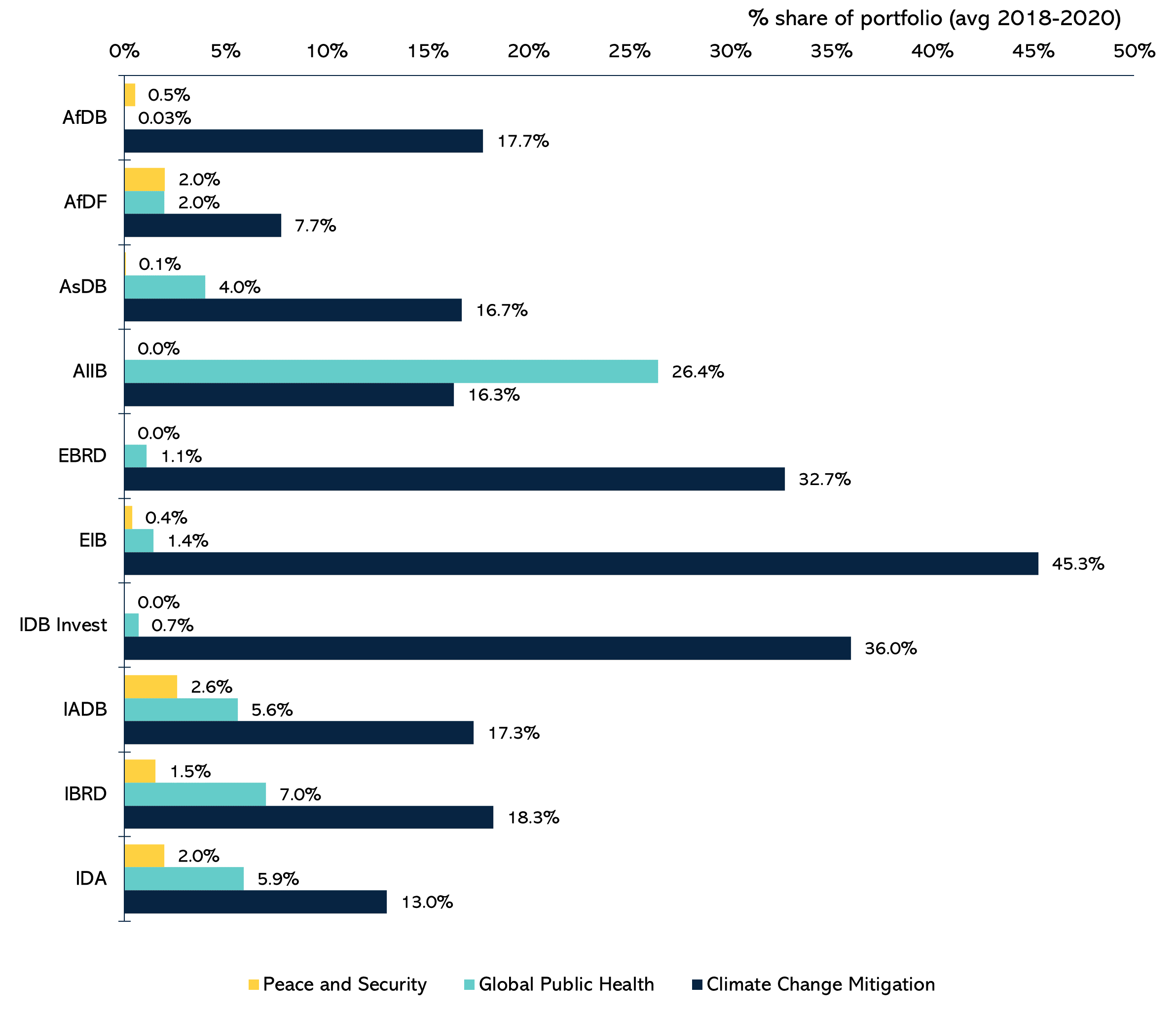More than meets the eye? Assessing MDBs’ contribution to tackling global challenges
March 7, 2023
In its scale and duration, the Covid-19 pandemic was a stark reminder that global challenges need global solutions and coordination. Meanwhile, pressure to contain the increase in global temperatures has escalated. Conflict and violence are on the rise.
The international response to these challenges is nowhere near enough. This can partly be explained by the theory of the under-provision of global public goods (GPGs). When benefits are non-excludable (it is hard to prevent others from experiencing them) and non-rival (consumption by one party does not reduce the amount to be consumed by others), countries might not be willing to borrow and foot the bill when benefits are largely enjoyed beyond their own borders.
Multilateral development banks (MDBs) are – in principle – well-placed to address global or regional challenges. From an operational perspective, international organisations like MDBs should be able to deal with the tension between national sovereignty and GPGs, providing technical assistance and concessional finance to help countries reconcile domestic and global goals.
The shareholders of the World Bank, in particular, want it to step up its efforts to tackle global challenges such as climate change mitigation, global public health (GPH) and peace and security. But what is the World Bank and the other large development banks already doing to help address these global challenges? How can we assess their contribution?
How MDBs help address global challenges
The theory of GPGs is only partly relevant in understanding how MDBs are helping to tackle global challenges. There is much more that MDBs already do – or that they should do differently.
First, while a number of activities in the MDB portfolio are not ‘pure’ GPGs, i.e. they are either excludable or rival, they still matter in addressing global challenges. Consider investments in renewable energy generation. Access to energy is still excludable and rival, but reductions in carbon emissions can be counted as a GPG.
Second, investments that tackle global challenges might already be driven by national priorities. An example is the creation or expansion of vaccine manufacturing facilities – a strategic national industry that also builds future pandemic preparedness.
Third, projects and programmes of MDBs can also make an indirect contribution to tackling global challenges. There are a number of complementary activities that are not strictly defined as GPGs, but that do prepare countries to produce and consume them. Policy experts refer to this as creating an ‘enabling environment’. Examples are greening regulation (building standards, vehicle standards, financial risk disclosure requirements) to facilitate investment in lower-carbon alternatives, or investment in public health systems to enable effective disease surveillance and outbreak preparedness and response systems. The policy advice and technical assistance that MDBs offer to client countries often run along these lines.
Finally, in their operations MDBs should not undermine global objectives. For example, MDBs should not invest in fossil fuel power generation. In the unlikely event that this is genuinely the cheapest form of electricity available in a country, governments should be able to secure private investment.
How much have MDBs contributed financially to tackling global challenges?
Unfortunately, development finance reporting does not straightforwardly have a box to check whether a project contributes to a GPG. We focused on three areas currently under discussion in the World Bank Evolution Roadmap: GPH, peace and security and climate change mitigation.
First, we identified the sub-sectors of official development finance (as identified by the OECD Creditor Reporting System (CRS)) that are relevant to GPH and peace and security. Within the CRS, we selected those sub-sectors whose projects and programmes are cross-border, non-excludable and non-rival. Then, to accurately capture spending and investment towards climate change mitigation, we used the OECD DAC statistics for multilateral climate-related external development finance flows. In doing this, we included a number of activities that are not strictly speaking GPGs, but where some of the benefits are (e.g. renewable energy transmission).
There are of course limitations to this analysis. We focus on broad sub-sectors rather than projects as we have limited information on the latter. Under this methodology, we do not map activities that might undermine the contribution of MDBs to addressing global challenges (e.g. investment in fossil-fuel technologies) as this requires a detailed project assessment. If these were instead accounted for, the value of projects, which are considered counterproductive to addressing global challenges, should be subtracted from the numbers we report below. Finally, we do not capture the potential synergies between investments in tackling each global challenge: for example, reducing emissions (and therefore global warming) will potentially benefit health and reduce the risks of conflicts associated with natural resources or displacement. The files at the bottom of this insight explain the method applied and share the underlying data. Despite these limitations, our calculations provide a useful first assessment of MDBs’ contribution to GPGs.
For each global challenge, we summarise the volumes of official development finance of the seven largest MDBs – and their main windows – over time, and the share of their total portfolio in recent years. See Figures 1 and 2.
By far climate change mitigation is the global challenge MDBs have spent the most on, as it usually involves large-scale investments in renewable energy and transport. Financing of climate change mitigation across MDBs also significantly rose over time, more than doubling between 2013 and 2020, even without changing the MDB financing model. This increase largely surfaces as a response to a greater urgency from shareholders who are contributing to international climate commitments to reduce GHG emissions (and better reporting). A forthcoming ODI Insight shows that most of the increase is the result of repurposing of projects and programmes (e.g. from fossil fuel to renewable energy projects) rather than expanded finance.
The World Bank Group is the largest financial contributor. Between 2018 and 2020, its funding to climate change mitigation amounted to nearly $30 billion, or about 40% of all finance for climate mitigation across MDBs. Even if MDBs like the EBRD and IDB spend less than others in absolute volumes, they are proportionally investing more in climate mitigation because they include several high greenhouse gas (GHG) emitters in their client base. Financing for climate change mitigation between 2018 and 2020 reaches nearly half of the EIB Global’s portfolio (45.3%). In comparison, this was only 15.6% for the World Bank Group, over the same period. Smaller volumes towards climate change mitigation at the AfDB/AfDF reflect lower demand from African countries where funding is mainly concentrated on climate adaptation, not covered here.
Prior to 2020, the World Bank Group and IADB were the only MDBs providing significant financing for projects and programmes promoting GPH. Unsurprisingly, support for GPH-related programmes across MDBs shot up at the start of the Covid-19 pandemic in 2020, to provide countries with additional financing for their response. Total financing to GPH by the seven MDBs more than quadrupled between 2019 and 2020. Almost half of that increase was attributed to projects and programmes related to pandemic control and prevention (the rest being attributed mostly to STD control including HIV, followed by health policy administration and education, medical services and research). In terms of overall volume in 2020, IDA and the IBRD still contributed more than half of funding (51.8%) of total GPH spending across the seven MDBs. Yet the AIIB, the AfDF, the AsDB and the EIB started or significantly ramped up their GPH portfolios when the pandemic hit, while all other MDBs only marginally increased their assistance in this area.
It is worth stressing that financing projects and programmes that promote peace and security does not equate to financing fragile and conflict-affected countries (FCAS). Only a subset of activities where MDBs operate in FCAS are counted as financial contributions to peace and security. The case of the AfDB and AfDF is clear: in 2018–2020, they spent 26.3% of their combined portfolio in FCAS, but each spent only about 2% or less in projects and programmes that directly support peace and security objectives. Most MDBs spend little or nothing at all. The World Bank and the IADB are the most active MDBs, both in terms of overall volumes and shares of their portfolio. Under this global challenge spending patterns are less clear, mainly as peace and security spending usually responds to sub-regional/country-specific demands rather than regional and global shocks. Activities supporting peace and security are not easy to design and implement but they are usually less (financially) resource-intensive than infrastructure projects – often the main focus of projects linked to climate change mitigation – or can involve non-state actors. Activities often aim to develop institutions that are legitimate, capable and effective; achieving lasting results can take time, and progress can be difficult to measure.
Figure 1: MDB commitments on peace and security, global public health and climate change mitigation, 2013–2020

Note: The IFC is only counted under climate mitigation. It only reports to the OECD climate finance database, not the CRS. This data cannot be used to derive a total GPG contribution across the three themes, unless the double counting of climate change mitigation finance is accounted for. See Method Note and Data Annex for details and commitments by each MDB.
Source: Authors’ calculations based on OECD-CRS and OECD-Climate Finance database
Figure 2: GPG finance as share of total MDB portfolio, by theme (average 2018–2020)

Notes: The share of portfolio is based on a three-year average (20182020) of commitments to each GPG theme based on the total portfolio commitment reported to the OECD-CRS by each MDB. This data cannot be used to derive a total GPG portfolio share across the three themes. See Method Note and Data Annex for details.
Source: Authors’ calculations based on OECD-CRS and OECD-Climate Finance database
Conclusions and future analysis
Mapping the relevance of the activities of MDBs to global challenges is far from simple. The theory of GPGs is only partly helpful as MDBs support climate change mitigation, GPH and peace and security indirectly too, and via technical assistance and policy advice usually attached to programmes and projects. MDB activities should also not undermine efforts towards a low-carbon transition, for instance by locking-in projects in fossil-fuel technologies. MDBs should consider what other areas, currently undersupplied, they should invest or expand in (e.g. surveillance for pandemic preparedness, decommissioning of coal plants).
Any discussion of the role of MDBs – particularly the World Bank – and any reform of operational models to tackle global challenges requires a much better understanding of what activities matter and how. A clear priority across MDBs would be a tracking and reporting system to measure trends and impacts over time.
And it is worth stressing that no single actor on their own can offer programmes and projects to solve global challenges. Solutions require concerted action at the national and regional level, complemented by collective, international action. Any reform of the World Bank must look at capacities and complementarities across the system.
Learn more